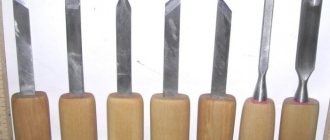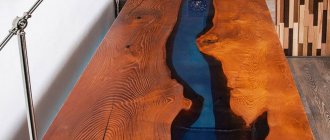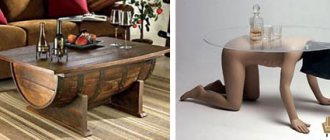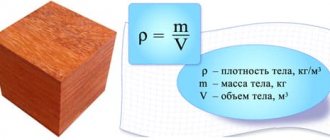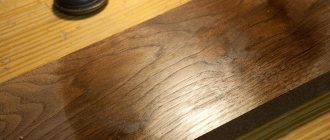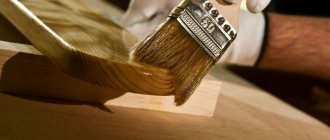Features and purpose
They produce different stain compositions, but the range of impregnation functions does not change.
- Wood tinting without radical changes in structure and natural pattern. The composition only lifts the fibers of the material. Even a simple array looks expensive after processing.
- The stain has bleaching properties. This quality is used by restorers to return products to a presentable appearance, as well as by craftsmen when preparing material for color varnishing.
- After impregnation, the wood fibers are strengthened, which helps restore the structure.
- The product creates a protective layer against microbiological processes and prevents damage to the material by parasites.
- Coating wood with stain increases moisture resistance, especially when using separate compounds that create a water-repellent effect.
- Treated products are not subject to premature destruction. Their service life increases significantly.
- By using different shades of stain, it is possible to imitate a combination of different types of wood on one object.
This coating is very popular due to its versatility.
Professionals call stain stain. A liquid product is always used when working on old wood to restore its aesthetic qualities.
Features of choosing a stain
Before choosing a composition for wood, it is worth understanding where it will be used. There are solutions for external and internal use. When selecting a protective agent, it would be useful to decide on the tool that will be used to process the coating. There are stains that are applied to the material with a brush, and some may require the use of a spray gun.
If you need to cover objects located indoors, then you should give preference to oil or wax options. They have practically no volatile compounds. Alcohol solutions are ideal for processing products placed outdoors. Such compositions must be applied using a spray gun. When purchasing stains, you should pay attention to their purpose. So, each type is designed for a specific type of wood.
You can purchase wood stain in the TBM-Market online store in Moscow. German-made stains are especially popular, characterized by high quality and excellent performance properties. Compositions created under the Hesse brand are environmentally friendly and absolutely safe for human health. The presented stains can radically change the appearance of wood, ennoble it and protect the material from external influences.
What are the types
The products differ in their composition components, technical and operational characteristics. Depending on the chemical formula, they are used for interior and exterior work.
Water-based stain for porous surfaces Aquacolor, color – pine wood
Water
Stains of this type are made on the basis of water. Available in two forms: ready-to-use and dry. The color range is varied. After application to wood, it is possible to enhance the natural tone of the natural material, lighten or darken it. It takes 4-14 hours to dry. The process is quite long, but it is necessary for complete evaporation of moisture.
The aqueous composition penetrates deep into the wood structure, resulting in reliable protection against rotting. Other advantages of impregnation include:
- environmental friendliness (can be used even in children's rooms);
- no unpleasant odor;
- the ability to wash off before drying;
- easy change of tone in subsequent treatments;
- hiding wood fiber defects.
The tinting effect is so impressive that many people choose colorless varnish as a decorative coating.
After treatment with water impregnation, the wood fibers are raised. To eliminate unevenness, it is necessary to sand the surface with a fine abrasive or rag.
With all the advantages of water stain, there are also negative sides. This coating does not provide moisture-resistant protection. Therefore, it is not recommended for use on street objects.
Wax
Developed on a wax basis. The principle of operation is different from other types. The active substances of the composition do not penetrate deep into the structure, but remain on the surface, creating a water-repellent film. The tree acquires moisture-resistant properties. The effect is so great that a wax-based product is used to treat wood surfaces located in saunas, steam rooms, and baths. It can also be used to protect street structures.
Wax stain is applied as a base before varnishing or painting. This preparation eliminates the formation of stains or unevenness after coating the wood with paint and varnish.
Oily
To make oil stain, synthetic and natural oils and dyes soluble in drying oil (white spirit) are used. This composition has a number of advantages over other types:
- there is no unpleasant odor;
- thanks to tinting, you get a beautiful and durable color that does not fade for many years;
- no toxic substances are used in the manufacture of impregnation, which indicates the environmental friendliness of the coating;
- A moisture-protective layer is formed on the surface of the wood, preventing liquid from penetrating into the structure.
The properties of oil stain are used to treat furniture, floors, parquet and other wood surfaces indoors. The material is not suitable for outdoor use due to its low resistance to UV rays, unless special substances that protect against ultraviolet radiation are used in production.
After application, oil stain dries within 10-48 hours, depending on the temperature and humidity level in the room. You can begin further finishing only after the impregnation has completely dried.
Acrylate stain Tikkurila Pirtti Panel Stain
Acrylic
Impregnation is available in liquid form. The color palette is impressive: almost all tones are found, identical to different types of wood. Acrylic compositions are distinguished by the absence of toxic substances, quick drying, and reliable protection from moisture, ultraviolet radiation and rotting. After application, no smudges, stains, or stains form on the surface. The coating turns out perfectly smooth.
Acrylic stain does not have a strong odor. The product is considered safe for people, animals and the environment.
Alcohol
The composition is based on alcohol or an organic solvent. A sign of the presence of the second component is the prefix NITRO in the name. The product is available in ready-to-use form or in powder, which must be dissolved in alcohol/white spirit before applying to wood.
The peculiarity of the stain is quick drying. It only takes 5-30 minutes for volatile substances to evaporate. It must be applied quickly; it is recommended to use a spray gun or spray gun for the job. To dilute the thickened alcohol stain, you need to add a little solvent to it.
Purpose: outdoor work. It is not recommended to use the product indoors due to its high toxicity.
| For interior work | For outdoor use |
| Wax | Alcohol |
| Water | Wax* |
| Oily | Oil* |
| Acrylic |
*For outdoor use, stains are selected that contain special substances that increase resistance to UV rays.
Acrylic and wax stains
Wax-based stain and acrylic wood stain belong to the latest generation of products of this type, which are devoid of many of the disadvantages inherent in the classic types. An important advantage of acrylic compositions is the formation of a beautiful surface, tinted in almost any color, and the acquisition of moisture- and water-repellent properties.
Can be applied evenly in one or two layers using different tools. They are used mainly for decorating furniture or interior elements, but their high wear resistance allows their use for finishing wooden floors or parquet boards.
The drying time of acrylic stains is short, and, in addition, they are safe for human health both at the work stage and during operation, since they are not a source of unpleasant odors and toxic fumes.
If you are interested in the question of whether it is possible to apply stain to stain, then in the case of using a wax composition, the answer will be positive.
The main purpose of such stains is to treat surfaces already decorated with other types of stains with soft wax to improve their performance characteristics. Considering that they are a substance in the form of softened wax, fabric swabs are used for their application, and the surface treatment process involves rubbing the composition with smooth movements.
Wax stain is often used as a finishing layer after the wood bleaching procedure, for which special compounds based on hydrogen peroxide or acids are used.
How to choose
When choosing a stain, it is important to consider not only the tone, but also other factors.
Manufacturer
The product does not always correspond to the properties declared by the manufacturer. The main reasons are various violations of the manufacturing process and the use of low-quality components.
It is recommended to give preference to well-known manufacturers who pay great attention to the quality of their products. The ranking positions are occupied by the following brands:
- Tikkurila;
- Dulux;
- WACHS;
- FARBITEX;
- Varathane;
- Zar;
- Osmo;
- BORMA.
Color
The color schemes of different types of stains differ. Water-based, they have predominantly natural shades. These are brown tones in the spectral range from light to dark. Acrylic paints have the richest palette. For example, the Tikkurila palette consists of 36 colors. You can also find a suitable color among oil and alcohol compositions. Poor choice of tones for wax and gel stains.
| Neutral color scheme | Shades of grey, white and black |
| Natural colors | Natural wood tones: oak, cherry, maple, wenge, walnut, etc. |
| Exotic color scheme | Non-standard color solutions: purple, blue, etc. |
The following tones are in greatest demand:
- ebony (aged wood effect);
- beech (natural wood);
- cherry (red and maroon tones);
- oak (deep brown);
- rowan (pale pink shade);
- mahogany (red shadow);
- fern (brown with green);
- ash (pinkish shadow);
- mocha (coffee shade);
- plum (dark pink tint);
- maple (delicate peach).
Each tone, according to the international classification, is assigned a specific marking. In fact, manufacturers develop their own range of colors. Therefore, experts advise using compounds of one brand when performing large-scale work.
What determines the final shade?
- natural wood color;
- structure density;
- quality of surface preparation;
- number of layers of impregnation.
Sometimes it is impossible to predict the end result, especially if you want to get a light shade from a dark tone. You have to select colors experimentally, using a small piece of wood, brighteners and several tones of stain.
Wax-based compounds
Wax stains appeared on the mass market relatively recently, but have already proven themselves well. These formulations do not contain water. They are applied to the tree superficially, without penetrating into its structure. Wax mixtures form a continuous protective film on the surface. Typically used for external work. Most often, wood is treated with wax before applying various types of paints and varnishes. The wax completely seals the wood pores, which ensures uniform application of paintwork materials and their economical consumption. Wax compositions should be applied using soft and completely dry tissue swabs. This eliminates the formation of stains and makes it possible to create a continuous wax film with a high degree of moisture resistance.
Treating wood with stain
The processing process can be divided into several stages, the sequence itself will give the desired result and a clear texture of the processed wood.
Stain, how to apply it and how deep does it penetrate? How to - Wood Stain
Preparing the wooden surface
To obtain an aesthetic finish, thoroughly prepare the surface before applying stain.
- If there is old paint or varnish, it must be cleaned. For these purposes, you can use any means that do not destroy the wood structure.
- Products made from coniferous wood must be de-resined.
- The clean surface is sanded in two passes. The first is performed using sandpaper No. 120, the second - with abrasive No. 220. You need to sand the wood moving along the grain. Dust is removed with a damp cloth. Dirty stains are removed with a rag soaked in solvent.
The wood should be dried before applying the composition.
How to breed
When purchasing dry stain, you need to dilute the powder before you start working. You must do it strictly according to the instructions indicated on the label. Water, alcohol or another product offered by the manufacturer is used as a solvent.
Ready-to-use stain may thicken during the sales process. Therefore, it must be thoroughly mixed, and then, if necessary, diluted with a small amount of solvent corresponding to the base of the composition.
Alcohol stain produced in dry form should not be diluted with water. The components of the composition dissolve only in the base for which the powder is intended.
To obtain the desired color, it is allowed to combine several colors of the palette. But all fighters must be of the same type. The best solution is to use not only the same type of stain, but also the same brand.
How to apply correctly
Coating work should begin after covering the work area with film to protect it from contamination. The application technique is no different from painting. The following principles are observed:
- apply evenly, trying not to go into the areas covered;
- You should not put a lot of product on the brush because of the risk of streaks and smudges;
- the tool must make movements parallel to the wood fibers;
- 2-3 layers of impregnation are formed with intermediate drying.
For stains with low viscosity, the method of applying impregnation using a spray gun is recommended. Oil, wax and acrylic types are distributed over the surface with a brush, roller or spray.
To obtain an unusual effect, rub the oil stain over the wood surface with a rag. As a result, the budget material becomes similar to oak. Raised wood fibers that appear after using water stain are cleaned off using a coarse cloth, which is passed in a diagonal and longitudinal direction.
Do not apply stain to a layer of paint or varnish. Decorative coatings form a durable layer on the surface through which the stain does not penetrate, which means it will not be able to saturate the wood structure and perform its functions.
What to coat after staining
Later it can be treated with varnish or paint. The first option is considered preferable, since a unique natural pattern remains on the surface.
Non-alcohol varnishes can be applied over alcohol stains. Water-based stains are combined with non-aqueous varnishes. Such solutions eliminate the formation of tears and irregularities on the treated surface.
If you don’t like the color after processing, you can correct the situation by removing it. Water-based stain is washed off with plain water. Alcohol-based compounds are removed with alcohol or white alcohol. If there is a desire to lighten the color of the product, after treating with a solvent, wipe the surface with a rag soaked in bleach. To consolidate the effect, use a vinegar solution (1 tsp per 400 ml of water).
A chlorine-containing solution does not always cope with lightening. In such cases, it is recommended to purchase a special wood bleach or stain with a bleaching effect.
How long does it take to dry?
The drying time of the stain depends on the base composition. Experts do not recommend speeding up the process by blowing the wood with a heating device. Hot air flow can reduce protection and appearance.
| View | Drying time |
| Water | 4-14 h |
| Alcoholic | 5-30 min |
| Acrylic | 4-5 hours |
| Wax | 1-10 h |
| Oil | 10-48 h |
Drying time depends on the temperature and humidity of the environment.
Stages of painting a wooden surface with stain.
If the wooden surface is properly prepared for painting, then the procedure for applying stain will be quite simple. It is performed in the following steps:
1. First, the stain needs to be warmed up a little to increase its penetration into the wood.
2. A brush, rag or swab is moistened with stain. Do not under any circumstances allow excessive moisture, as drips may appear and the coloring will become uneven. If a sprayer is used, the stain is poured into the tank.
3. The stain is applied along the wood fibers. It is necessary to apply the stain quickly and without interruption to avoid stains. If drips appear, the surface should be wiped with a cloth, collecting excess liquid along the fibers. Then the surface is left until the stain dries completely.
4. Similarly, several more layers of stain are applied in order to obtain the desired shade (usually 2-3 layers).
How to make wood stain with your own hands
It can be replaced with decoctions of different plants, which are selected depending on the desired shade.
| Components for stain | What color do they give? |
| Oak bark/alder bark | black |
| Fruits of unripe buckthorn | yellow |
| Willow bark + nut shells | noble brown |
| Larch | red tint |
| Onion peel | Dark red |
You can make acrylic stain by diluting acrylic paint with water. To do this, pour clean liquid into the container in a volume corresponding to the surface being treated. Next, paint is added to it with constant stirring. To obtain the desired shade, it is necessary to do test colors.
An alternative option involves using coffee. Natural grains are crushed and brewed for 5 minutes. Then add liquid to the required volume and leave for a couple of hours. The strained solution paints the wood a rich brown tone.
Popular fighters
Zar Wood Stain Oil Based Wood Stain
Tinting impregnation is suitable for wood, plastic, steel. One layer is enough to get rich color. When working with the coating, streaks and smudges do not form. There is no pungent odor.
| Purpose | for interior work |
| The basis | oil |
| Surface type | tree |
| Properties | dries quickly and is moisture resistant |
| Color | Walnut |
| Consumption when using the rubbing method | 0.946 ml per 65-70 m2 |
| Consumption when using a brush | 1 quart per 30-35 m2 |
| Drying time | 3-4 hours |
| price, rub. | 710 |
Solvent stain for pine CL 58-5719 “Sandalwood” 1l
The impregnation is ready for use and does not require preliminary dilution. Feature – high light fastness. The composition penetrates well even into the dense structure of wood. When applied, it is evenly distributed over the plane. The highlight of the stain is high German quality.
| Purpose | for interior work |
| The basis | organic solvents |
| Surface type | tree |
| Color | sandalwood |
| Spray consumption | 1 l per 5-8 m2 |
| Application method | pneumatic spray |
| Drying time | 2 hours |
| Further processing | water-based varnishes, polyurethane and nitrocellulose varnishes |
| price, rub. | 484 |
Wood stain oil Varathane Wood Stain Dark Walnut jar 0.946l
An environmentally friendly product, for the production of which plant raw materials are used. Beitz has the ability to penetrate deeply into the wood structure, emphasizing the natural pattern. A rich color is obtained even after one surface coating. The product applies smoothly without forming spots or streaks. When used on soft woods, pre-treatment with conditioner is recommended.
| Purpose | for interior work |
| The basis | soybean oil |
| Surface type | tree |
| Color | dark walnut |
| Consumption per layer | 0.946 l per 25m2 |
| Drying time | 1 hour |
| price, rub. | 2124 |
Non-aqueous stain NBCH, ebony color 0.5 l
The composition gives the surface noble shades, the intensity of which depends on the number of layers and the original color of the wood. The main purpose is interior work. But subject to subsequent varnishing, it can be used externally.
| Purpose | for interior work |
| The basis | aqueous polymers |
| Surface type | tree |
| Color | ebony |
| Consumption per layer (brush, roller) | 100 ml/m2 |
| Complete drying time | 4 hours |
| Interlayer drying time | 2 hours |
| price, rub. | 72 |
Acrylic-based compositions
Acrylic stains are produced only in the form of liquid mixtures. They come in a wide variety of colors. If necessary, the desired shade can be easily obtained by mixing compositions of different color palettes with each other. These stains have good performance characteristics in all respects. They do not emit volatile toxic substances and do not emit an unpleasant odor. In addition, the compositions provide reliable protection of wood surfaces from moisture/water. Also, acrylic impregnations form an even film after application and dry very quickly. They have only one drawback - the high price.

